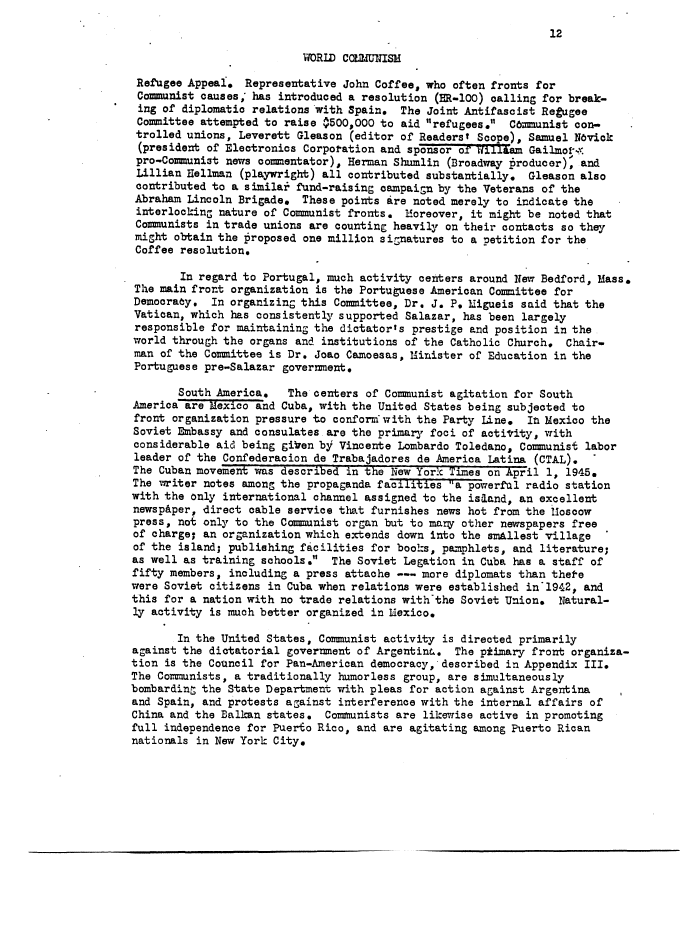 |
||||
 |
||||
| 12 'kYORID COMMUNISM Refugee Appeal* Representative John Coffee, who often fronts for Communist causes; has introduced a resolution (ER-100) calling for break- ing of diplomatic relations with Spain. The Joint Antifascist Regugee Committee attempted to raise 0500,000 to aid "refugees." Communist con- trolled unions, Leverett Gleason (editor of Readerst Scope), Samuel Nfivick (president of Electronics Corporation and sponsor of William Gailmof-->: pro-Communist news commentator), Herman Shumlin (Broadway producer)^ and Lillian Hellman (playwright) all contributed substantially. Gleason also contributed to a similar fund-raising campaign by the Veterans of the Abraham Lincoln Brigade, These points are noted merely to indicate the interlocking nature of Communist fronts. Moreover, it might be noted that Communists in trade unions are counting heavily on their contacts so they might obtain the proposed one million signatures to a petition for the Coffee resolution. In regard to Portugal, much activity centers around New Bedford, Mass. The main front organization is the Portuguese American Committee for Democracy. In organizing this Committee, Dr, J. P. Migueis said that the Vatican, which has consistently supported Salazar, has been largely responsible for maintaining the dictator»s prestige and position in the world through the organs and institutions of the Catholic Church, Chair- man of the Committee is Dr. Joao Camoesas, Minister of Education in the Portuguese pre-Salazar government. South America. The centers of Communist agitation for South America are Mexico and Cuba, with the United States being subjected to front organization pressure to conform"with the Party Line. In Mexico the Soviet Embassy and consulates are the primary foci of activity, with considerable aid being gifren by Vincente Lombardo Toledano, Communist labor leader of the Confederacion de Trabajadores de America Latina (CTAL). The Cuban movement was described in the New York Times on April 1, 1945, The writer notes among the propaganda facilities "a powerful radio station with the only international channel assigned to the island, an excellent newspaper, direct cable service that furnishes news hot from the Uoscow press, not only to the Communist organ but to many other newspapers free of charge? an organization which extends down into the smallest village ' of the island; publishing facilities for books, pamphlets, and literature; as well as training schools." The Soviet Legation in Cuba has a staff of fifty members, including a press attache —• more diplomats than there were Soviet citizens in Cuba when relations were established in" 1942, and this for a nation with no trade relations with'the Soviet Union. Natural- ly activity is much better organized in Mexico. In the United States, Communist activity is directed primarily against the dictatorial government of Argentina, The piimary front organiza- tion is the Council for Pan-American democracy, described in Appendix III. The Communists, a traditionally humorless group, are simultaneously bombarding the State Department with pleas for action against Argentina and Spain, and protests against interference with the internal affairs of China and the Balkan states. Communists are likewise active in promoting full independence for Puerto Rico, and are agitating among Puerto Rican nationals in New York City. |